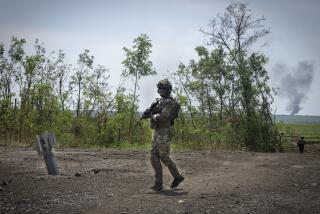A LOOK AT IRAQI DEFENSES
- Share via
With allied bombers mounting a concentrated air blitz on Iraqi supply lines and elite Republican Guard troops behind the front lines, U.S. military planners are setting the stage for what could prove to be a bloody but decisive confrontation between ground forces in the desert.
Conventional military wisdom calls for attackers to hold a 3-1 superiority in numbers before attempting to blast well-entrenched defenders out of their positions. But Pentagon planners are relying on U.S. technological superiority--which some experts describe as a World War III force seeking to overcome World War I-style fortifications-to rout the Iraqis.
SCENARIO:
The most likely scenario for the looming ground war, experts say, is a night-time, three-pronged allied attack--including land, air and sea elements. U.S. Army units, assisted by allied Arab forces, would thrust into Iraq west of the Kuwaiti border. U.S. paratroopers would drop behind Iraqi lines while Marines launch an amphibious assault.
POSSIBLE STRATEGIES
To punch holes in Iraqi defenses, some experts speculate that allied troops would:
* Start with massive artillery and bombing strikes. Heavy smoke might be used as a diversion to mask allied maneuvers.
* Employ repeated B-52, A-10 and Apache helicopter strikes.
* Use bulldozers and tanks with heavy rollers and exploding “line charges” to clear minefields.
* Use M-1A1 Abrams tanks to zip through the breach followed by Bradley fighting vehicles with infantrymen.
M-1A1 Abrams tanks: Will follow the bulldozer tanks and mine-clearing tanks, and will provide cover fire for the combat engineers. Has ability to speed along at 25 m.p.h. while firing.
M-3 Bradley armored fighting vehicles: These carry information who will be used to drive Iraqis out of foxholes and trenches.
AH-64 Apaches: The Army’s advanced attack helicopter is capable of undertaking full day/night/adverse weather anti-tank or other anti-armor missions. It is equipped with Hellfire missiles, a 30-mm cannon and a night vision system.
A-10 Thunderbolts: Primarily used as a tank fighter, these aircraft are armed with a 30-mm high-speed cannon, Maverick missiles and laser-guided bombs.
Bulldozer tanks: Used to clear paths for the tanks and infantry vehicles.
Foxholes: Used by soldiers to provide shelter from bomb and missile attacks.
Minefields: Often several hundred yards deep, they are made up of antitank mines--pressure miners that are activated by the weight of the tank--and anti-personnel mines--smaller, more sensitive and often activated by trip wires.
Sand berms: Are hazardous obstacles for tanks. If tanks try to drive over the berms, their underbellies are exposed to gunfire and their tops are vunerable as they descend.
Trenches: Manned by troops with machine guns and antitank guns. Trenches are reinforced with concrete-coated stell mesh, wire or reeds.
Fire-point berms: Used to hide tanks and antiaircract guns, which are dug in behind.
Antitank ditches: About 12 feet deep and 8 to 9 feet wide. Filled with “dragon tooth” barriers, metal spikes, burned-out vehicles and concrete blocks. 55-gallon drums of napalm that can be detonated by remote control.
Razor wire: Designed to entangle vehicle tread and slow infantry. It has to be cut or cleared by explosives or bulldozers.
Triangular strongpoints: These large triangular forts are made of sand piled up to form walls about 10 feet high. The corners house companies consisting of infantrymen, tanks and artillery guns. Ramps made of sand and gaps in the walls are used to enter and exit.
A typical layout of an Iraqi brigade position (8,000-12,000 meters) Companies positioned in corners (2,000 meters)
More to Read
Sign up for Essential California
The most important California stories and recommendations in your inbox every morning.
You may occasionally receive promotional content from the Los Angeles Times.













